Spica’s Spanker is a quadrilateral asterism formed by the brightest stars in Corvus. Also known as the Sail, the asterism appears near Spica, the brightest star in Virgo and the 16th brightest star in the sky. The pattern resembles the spanker, a type of small sail. It can be used to find the famous Sombrero Galaxy (Messier 104) in Virgo and the Antennae Galaxies (NGC 4038 and NGC 4039) in Corvus.
Spica’s Spanker is formed by Gienah, Kraz, Algorab, and Minkar. Even though the four stars are not exceptionally bright, they appear in a relatively dim region of the sky and easily stand out on a clear, dark night. They make it easy to identify the constellation Corvus (the Crow). Two of the stars – Gienah and Algorab – serve as pointers toward Spica.
In Chinese astronomy, the four stars formed an asterism called the Chariot (軫宿, Zhěn Sù). The asterism was one of the southern mansions of the Vermilion Bird of the South.
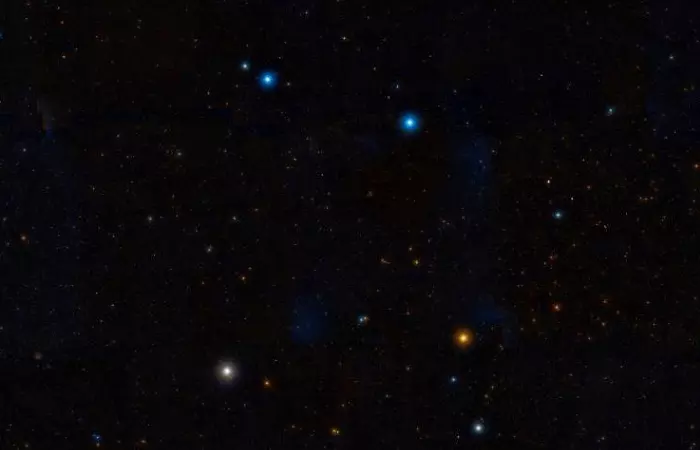
Spica’s Spanker (the Sail), image: Wikisky
Location
Spica’s Spanker is easy to find because it appears in the same area of the sky as Spica, one of the brightest stars in the sky. While Spica can be identified using the asterism, it is much brighter than the Corvus stars and can instead be used to find the pattern they form.
Spica can be found by following the arc formed by the three stars of the Big Dipper’s handle. The imaginary curved line extended from the handle leads first to the bright Arcturus in the constellation Boötes and then to Spica. Spica’s Spanker appears southwest of the star.
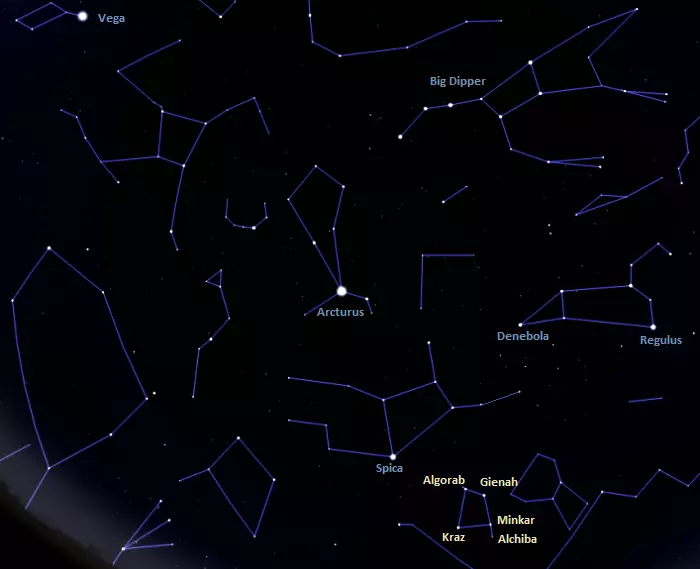
The location of Spica’s Spanker, image: Stellarium
The stars of Spica’s Spanker can be used to find the Sombrero Galaxy (M104), a famous spiral galaxy in the constellation Virgo. The galaxy appears 5.55 degrees east of Eta Corvi, a magnitude 4.3 star that appears next to the brighter Algorab.
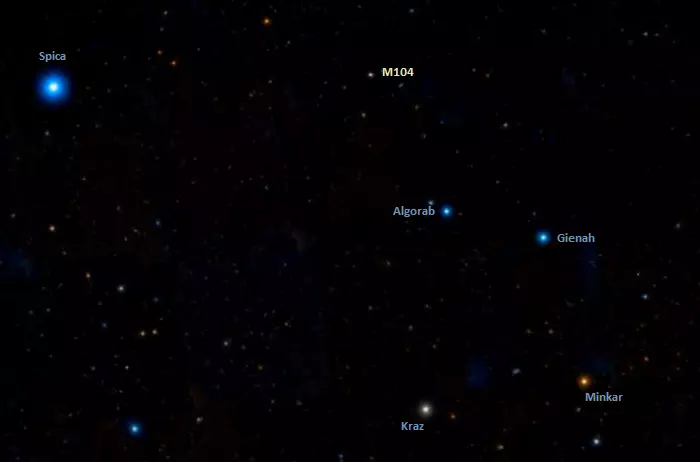
Spica’s Spanker, Spica and the Sombrero Galaxy (Messier 104), image: Wikisky
The bright globular cluster Messier 68 can be found 3.5 degrees south of Kraz, the bottom left star of the asterism. The cluster can be observed in small telescopes. It has an apparent magnitude of 7.8 and lies approximately 33,600 light-years away.
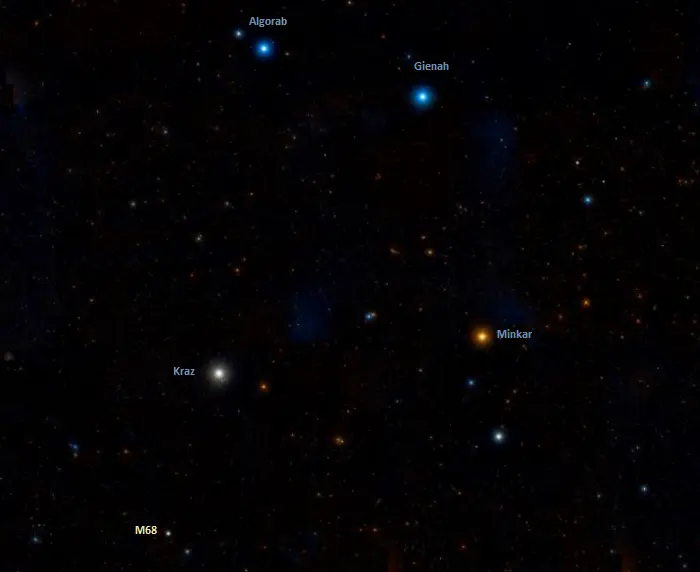
Spica’s Spanker and the globular cluster
Messier 68, image: Wikisky
The interacting galaxies NGC 4038 and NGC 4039, popularly known as the Antennae Galaxies, appear in the same area as the Sail asterism. The galaxies lie 45 and 65 million light-years away and have apparent magnitudes of 11.2 and 11.1. They show a possible future of our own galaxy, the Milky Way, when it collides with its larger neighbour, the Andromeda Galaxy (Messier 31).
The Antennae Galaxies are members of the NGC 4038 Group, which also includes the relatively bright spiral galaxies NGC 4027 and NGC 3981 and the elliptical galaxy NGC 4033. NGC 4038 and NGC 4039 are catalogued as Caldwell 60 and Caldwell 61 in the Caldwell catalogue of deep sky objects visible in amateur telescopes. They can be found just south of the imaginary line extended from Algorab through Gienah.
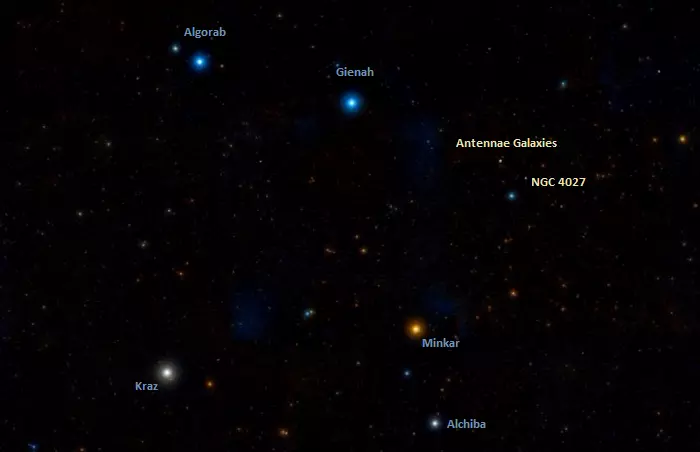
Spica’s Spanker and the Antennae Galaxies (NGC 4038 and NGC 4039), image credit: Wikisky
Stars
Spica’s Spanker is formed by Gienah (Gamma Corvi), Kraz (Beta Corvi), Algorab (Delta Corvi), and Minkar (Epsilon Corvi). The fainter Alchiba (Alpha Corvi) gives the quadrilateral pattern the appearance of a sail.
The four stars that form the asterism are more massive and luminous than the Sun. The nearest of the four, Algorab, lies 86.9 light-years away and the most distant, Minkar, lies 318 light-years away.
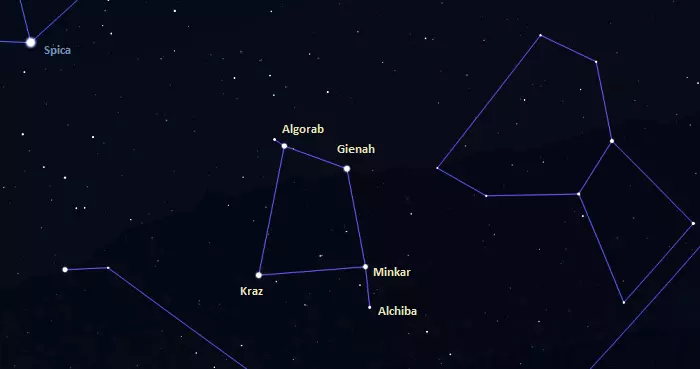
Spica’s Spanker stars, image credit: Stellarium
Gienah
Gienah (Gamma Corvi) is the brightest star in Corvus and, on average, the 100th brightest star in the sky. It shines at magnitude 2.585 from a distance of 154 light-years.
The star is a hot blue giant of the spectral type B8 III. It has a mass 4.2 times that of the Sun and is 331 times more luminous than the Sun. It has an estimated age of 160 million years.
Gienah has a companion, a red or orange dwarf with a mass of 0.8 solar masses. The two stars orbit each other with a period of 158 years at a separation of about 50 astronomical units.
The name Gienah is derived from the Arabic word for “wing.” The star marks the left wing of the celestial Crow. The name has the same origin as Aljanah (Epsilon Cygni). Aljanah is one of the stars that mark the wings of Cygnus (the Swan). It is part of the Northern Cross.
Even though it is the brightest star in the Corvus constellation, Gienah has the Bayer designation Gamma Corvi. The designation Alpha went to the considerably fainter Alchiba (mag. 4.03), the constellation’s fifth brightest star. The reason for this is uncertain.
Kraz
Kraz (Beta Corvi), the second brightest star in Corvus, has an apparent magnitude of 2.647 and lies 146 light-years away. Its brightness has been observed to vary between magnitudes 2.66 and 2.60.
Kraz is a yellow bright giant star of the spectral type G5 II. The origin of the name Kraz is uncertain.
The star has a mass of 3.7 solar masses and a radius 16 times that of the Sun. With an effective temperature of 5,100 K, it shines with 164 solar luminosities. It is believed to be 206 million years old.
Algorab
Algorab (Delta Corvi) is a white subgiant star of the spectral type A0 IV(n) kB9. It shines at magnitude 2.962 from a distance of 86.9 light-years. While it has the spectrum of a subgiant, Algorab may be a young stellar object that has not yet evolved on the main sequence. If it is a subgiant, the mysterious star is about 260 million years old, and if it is a pre-main-sequence star its estimated age would be about 3.2 million years.
Algorab has a mass of 2.74 solar masses and is 69 times more luminous than the Sun with a surface temperature of 10,400 K. It is an exceptionally fast spinner, with a projected rotational velocity of 236 km/s.
The name Algorab comes from the Arabic word for “the crow.”
Minkar
Minkar (Epsilon Corvi) is a red giant star of the spectral type K2 III. It has a mass 3.2 times that of the Sun and a radius 52 times solar. The name Minkar is derived from the Arabic word for “beak.” It is the star’s traditional name, but it has not been formally approved by the International Astronomical Union (IAU).
Minkar lies approximately 318 light-years away and shines at magnitude 3.024.